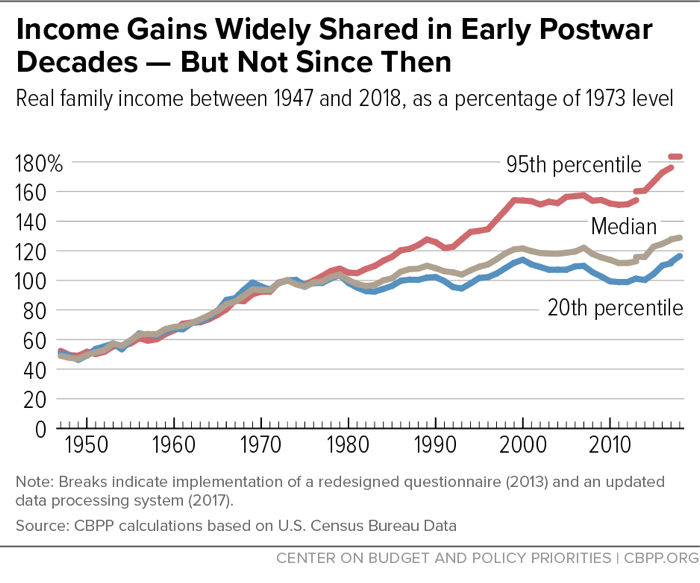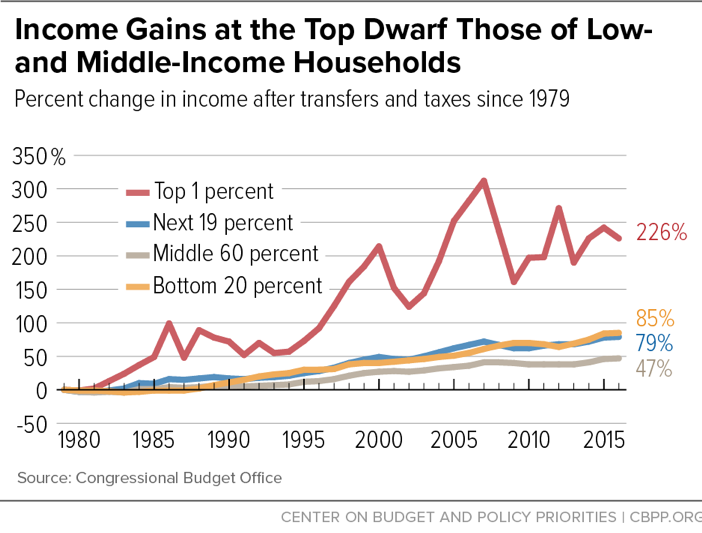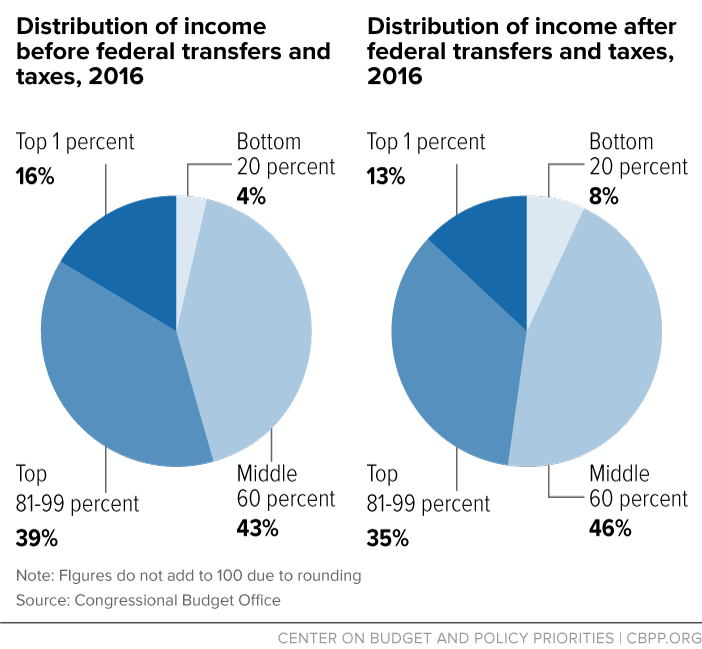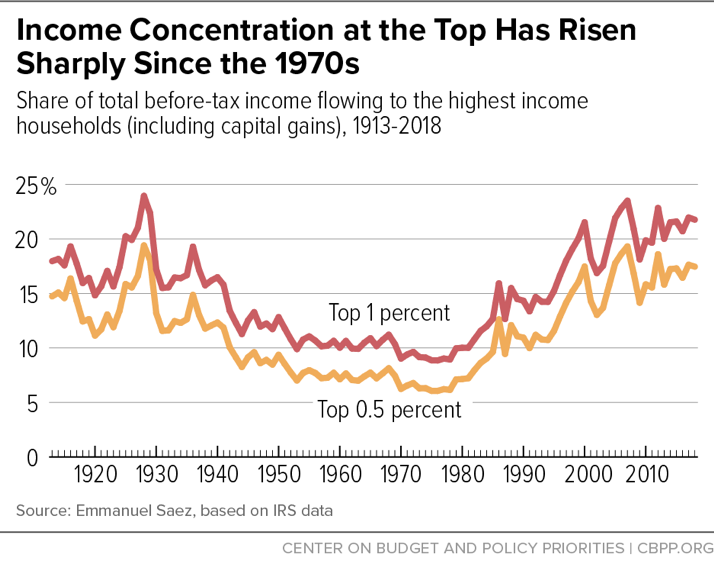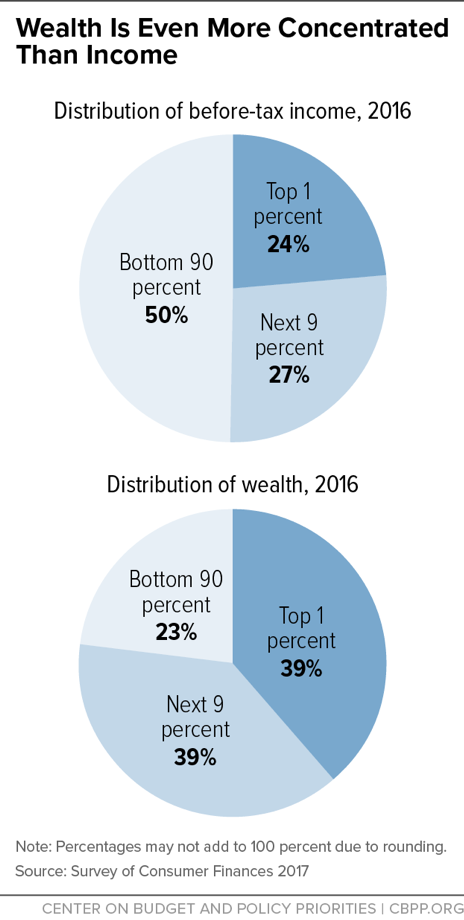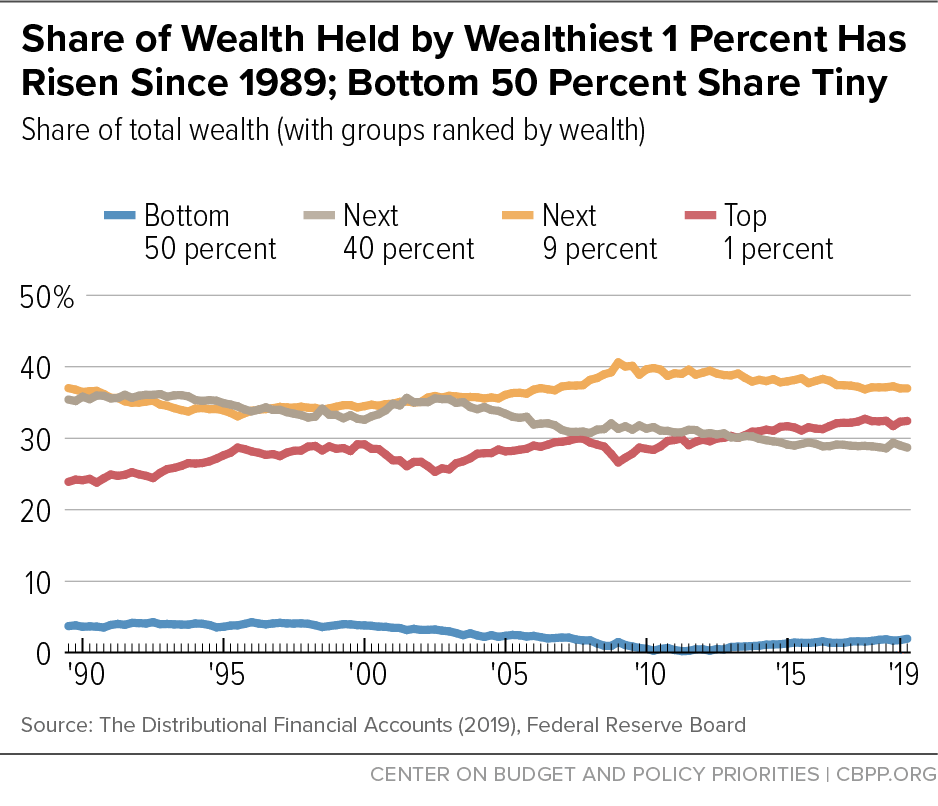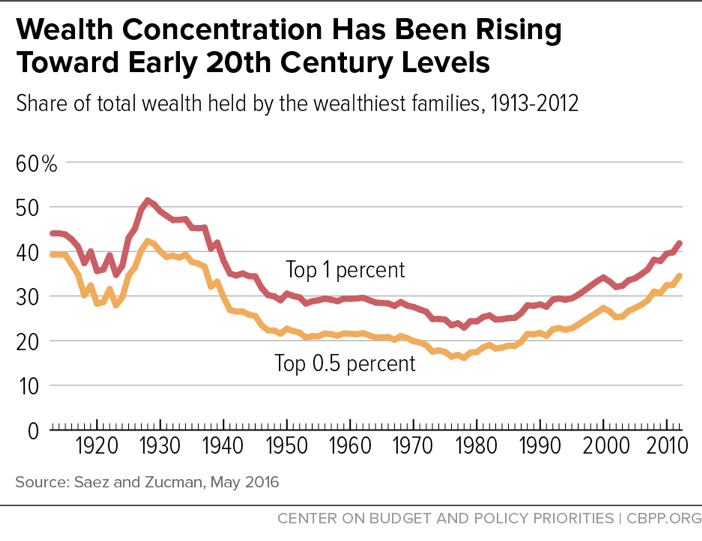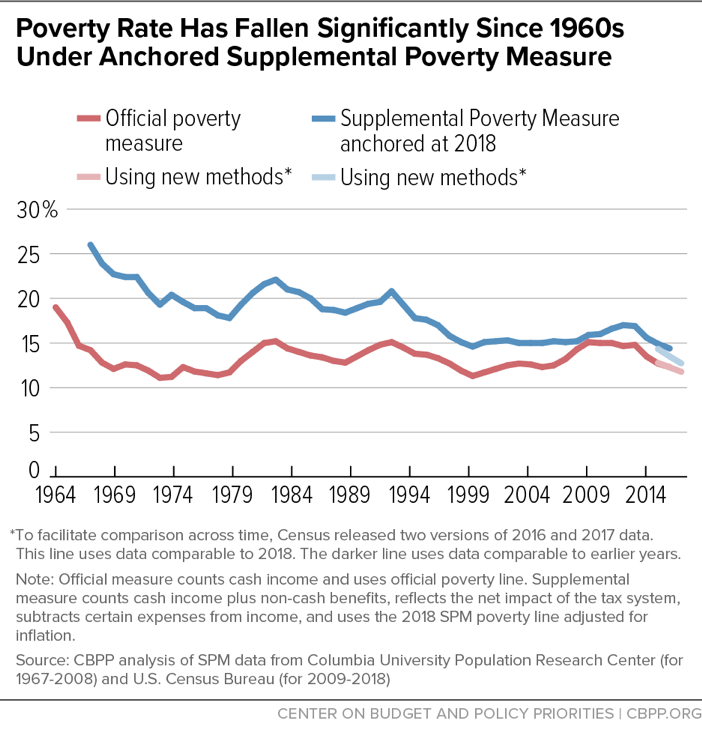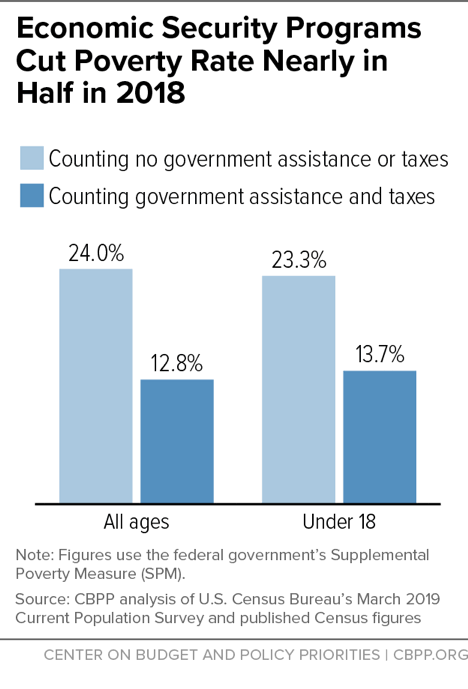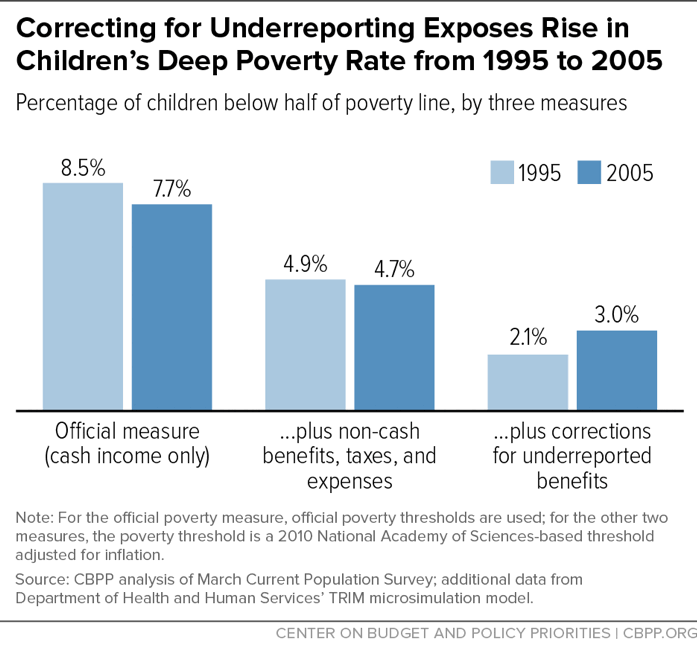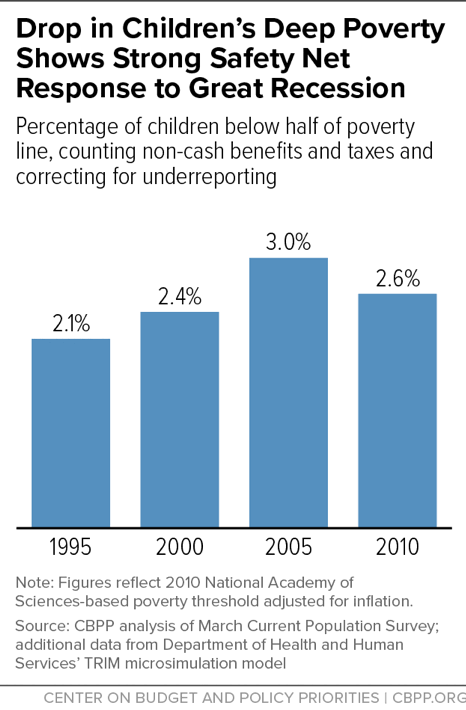End Notes
[1] See http://www.census.gov/topics/income-poverty/income.html.
[2] Internal Revenue Service, “SOI Tax Stats — Individual Income Tax Returns Publication 1304,” multiple years available, https://www.irs.gov/uac/soi-tax-stats-individual-income-tax-returns-publication-1304-complete-report.
[3] Jesse Bricker et al., “Changes in U.S. Family Finances from 2013 to 2016: Evidence from the Survey of Consumer Finances,” Federal Reserve Bulletin, Vol. 103, No. 3, September 2017, https://www.federalreserve.gov/publications/files/scf17.pdf.
[4] Congressional Budget Office, “The Distribution of Household Income, 2016,” July 9, 2019, https://www.cbo.gov/publication/55413.
[5] Emmanuel Saez, “Striking it Richer: The Evolution of Top Incomes in the United States,” University of California, updated March 2, 2019, https://eml.berkeley.edu/~saez/saez-UStopincomes-2017.pdf.
[6] See Emmanuel Saez and Gabriel Zucman, “Wealth Inequality in the United States Since 1913: Evidence from Capitalized Income Tax Data,” Quarterly Journal of Economics, Vol. 131, No. 2, May 2016, http://eml.berkeley.edu/~saez/SaezZucman2016QJE.pdf; Thomas Piketty, Emmanuel Saez, and Gabriel Zucman, “Distributional National Accounts: Methods and Estimates for the United States,” Quarterly Journal of Economics, Vol. 133, No. 2, May 2018, http://gabriel-zucman.eu/files/PSZ2018QJE.pdf; and Emmanuel Saez and Gabriel Zucman, The Triumph of Injustice: How the Rich Dodge Taxes and How to Make Them Pay, W.W. Norton and Company, 2019.
For a discussion of distributional analyses and frameworks currently in use, see Kevin Perese, “CBO’s New Framework for Analyzing the Effects of Means-Tested Transfers and Federal Taxes on the Distribution of Household Income,” Congressional Budget Office, December 2017, pp. 41-45, https://www.cbo.gov/system/files/115th-congress-2017-2018/workingpaper/53345-workingpaper.pdf.
[7] For 2018, approximately 94,600 housing units were in the sample for the ASEC. About 81,900 housing units were determined eligible for interview and about 68,300 interviews were conducted. Census Bureau, “Source and Accuracy of Estimates for Income and Poverty in the United States: 2018 and Health Insurance Coverage in the United States: 2018,” p. 3, https://www2.census.gov/library/publications/2019/demo/iphi-sa.pdf.
[8] Census also collects data on income, poverty, and health insurance coverage through the American Community Survey (ACS), which has replaced the long-form decennial census questionnaire. For its more limited set of categories, the ACS provides better data at the state and local levels than the CPS, but Census advises that the CPS data provide the best annual estimates of income, poverty, and health insurance coverage for the nation as a whole.
[9] The March supplement to the CPS was expanded to include interviews from February and April and renamed the ASEC in 2001.
[10] Examples of money income — sometimes referred to as “cash income” — include: wages and salaries; income from dividends; earnings from self-employment; rental income; child support and alimony payments; Social Security, disability, and unemployment benefits; cash welfare assistance; and pensions and other retirement income. Census money income does not include non-cash benefits such as those from SNAP, Medicare, Medicaid, or employer-provided health insurance.
[11] Census uses a three-parameter scale for equivalence adjustment that takes into account family size and composition. For example, a two-adult, one-child family has a different adjustment than a one-adult, two-child family.
[12] This is generally referred to as “top-coding” and is done to preserve confidentiality. In addition, in the public-use data files of the ASEC made available to researchers, Census takes further steps to preserve confidentiality for high-income individuals well below this limit by exchanging income values between individuals with very similar values in a procedure called “rank-proximity swapping.”
[13] Internal Revenue Service, “Individual Income Tax Returns 2017,” Publication 1304, Table C, September 2019, https://www.irs.gov/pub/irs-pdf/p1304.pdf.
[14] For the most recent estimates, see Congressional Budget Office (2019), op. cit.
[15] Households with negative income are excluded from the lowest income category but are included in the totals.
[16] Changes in the nature of health care spending also could affect measured income differently than they affect household well-being. For example, advances in medical technology could enhance the value to households of health care spending in ways that the income data would not fully capture. Conversely, spending increases on wasteful medical procedures or larger profit margins in the medical, insurance, or prescription drug industries could result in increases in health care spending that CBO counts as added income but do not enhance recipients’ well-being. A recent paper estimated that waste in the U.S. health care system accounted for approximately 25 percent of health care spending. William H. Shrank, Teresa L. Rogstad, and Natasha Parekh, “ Waste in the US Health Care System: Estimated Costs and Potential for Savings,” JAMA, October 7, 2019, https://jamanetwork.com/journals/jama/fullarticle/2752664.
[17] For details on their methods, see Thomas Piketty and Emmanuel Saez, “Income Inequality in the United States: 1913-1998,” Quarterly Journal of Economics, February 2003, or, for a less technical summary, see Saez’s latest update: “Striking It Richer: The Evolution of Top Incomes in the United States,” March 2, 2019, https://eml.berkeley.edu/~saez/saez-UStopincomes-2017.pdf. Their most recent estimates are available at https://eml.berkeley.edu/~saez/TabFig2018prel.xls.
[18] Piketty and Saez make available three different data series, each of which treats capital gains slightly differently and therefore yields somewhat different estimates of the share of income going to each group. (For example, estimates of the share of income going to the top 1 percent in 2018 vary from 18.46 percent in one series to 20.37 percent in a second series to 21.76 percent in the series we rely on here.) We follow the income concept in Saez’s most recent report and focus on the series that includes capital gains income both in ranking households and in measuring the income that households receive.
[19] More technically, Piketty and Saez calculate market income by taking the adjusted gross income reported on tax returns and then adding back all adjustments to gross income (such as deductions for health savings accounts, student loan interest, self-employment tax, and IRAs). Note that this definition of market income is not the same as the “market income” concept used in the recent CBO report described above.
[20] People with income below certain thresholds are not required to file personal income tax returns. Thresholds are determined according to age and filing status. For example, for 2018 returns filed in 2019, the filing thresholds were $24,000 for a non-elderly married couple and $13,600 for an elderly single person. Many people who are not required to file tax returns nonetheless pay considerable federal taxes, such as payroll and excise taxes, as well as state and local taxes.
[21] They estimate the total number of potential filers from Census data by summing the total of married men, widowed or divorced men and women, and single men and women over age 20. The number of non-filing tax units in their analysis is the difference between their estimated total and the number of returns actually reported in the IRS data. This methodology assumes the number of married women filing separately is negligible, and it has been quite small since 1948. Before that, however, married couples with two earners had an incentive to file separately, and Piketty and Saez adjust their data to account for that.
[22] For the years since 1943, non-filers, who account for a small percentage of all filers and of total income, are assigned an income equal to 20 percent of the average income of filers (except in 1944-45, when the percentage is 50 percent). For earlier years, when the percentage of non-filers and their share of income were much higher, Piketty and Saez assume, based on the ratio in subsequent years, that total market income of filers plus non-filers is equal to 80 percent of total personal income (less transfers) reported in the National Income and Product Accounts for 1929-1943 and as estimated by the economist Simon Kuznets for 1913-1928. For those years, the total income of non-filers is the difference between estimated total income and income reported on tax returns.
[23] According to data from the Bureau of Economic Analysis, wages and salaries now provide about 81 percent of employee compensation; supplemental benefits such as contributions to health and retirement plans provide the rest. In 1980, 85 percent of compensation came through wages and 15 percent through benefits; in 1950, 93 percent came through wages and 7 percent through benefits.
[24] For example, employer-sponsored health insurance benefits likely constitute a much smaller fraction of income for the top 1 percent than for the vast majority of middle-income tax units; their omission could understate income growth in the middle of the distribution relative to growth at the top.
[25] See Piketty, Saez, and Zucman, op. cit.
[26] They provide an alternative analysis in which the earnings of the members of a married couple are assigned to each member individually in order to examine gender inequality.
[27] Many of these choices are inherently arbitrary. In the case of spending on public goods like national defense, for example, how to assign benefits to individual households is more a philosophical question than one that can be resolved analytically or empirically. Piketty, Saez, and Zucman’s decision to use split-income couples in their base case (as opposed to, say, family size-adjusted measures, as CBO does) removes the effect of changes in family size on trends in inequality.
[28] Between 2014 and 2018, Census implemented improvements to the CPS ASEC, introducing new income questions and an updated data processing system to improve income reporting, increase response rates, and reduce reporting errors. In its historical tables, Census reports one set of statistics for 2013 based on the legacy questionnaire and another based on the redesigned questionnaire. Similarly, Census reports one set of statistics for 2017 produced under the old processing system and one produced under the updated system. Census advises caution in comparing estimates from 2018 forward with estimates from before 2017.
[29] When income increases by 100 percent, it doubles. When it increases by 300 percent, it quadruples.
[30] Congressional Budget Office, “Projected Changes in the Distribution of Household Income, 2016-2021,” December 2019, Figure 4, p. 15, https://www.cbo.gov/publication/55941.
[31] This discussion uses the Piketty-Saez estimates based on their analysis of IRS data alone. However, their more ambitious analysis of the distribution of all of national income shows a similar pattern of concentration at the top.
[32] In the Piketty-Saez data, average incomes in 2018 were about $1.5 million for the top 1 percent of households and about $2.3 million for the top 0.5 percent.
[33] Assets include such things as savings, stocks, vehicles, homes, and business and financial assets. Liabilities include such things as credit card debt, mortgages, and past-due bills.
[34] Bricker et al. (2017), op. cit.
[35] Ibid., “Box 3: Recent Trends in Income and Wealth.”
[36] Michael Batty et al., “The Distributional Financial Accounts,” FEDS Notes, August 30, 2019, https://www.federalreserve.gov/econres/notes/feds-notes/the-distributional-financial-accounts-20190830.htm.
[37] Because the two datasets underlying the distributional national accounts use somewhat different wealth concepts and are presented and measured at different frequencies (every three years versus quarterly), the precise changes in the share of different wealth groups over time in the SCF and the distributional national accounts are similar but not identical.
[38] Saez and Zucman (2016), op. cit.
[39] A recent Federal Reserve analysis tries to reconcile differences between the SCF and Zucman-Saez findings through measures such as including estimates for the wealth of the Forbes 400 in the SCF and adjusting upward the assumed rate of return on fixed-income assets held by those at the top in Zucman-Saez. The Fed researchers are able to narrow the gap between the two estimates of top-income shares, and they conclude that their estimates “concur that inequality, at least as reflected in top income and wealth shares, has been rising in recent decades.” See Jesse Bricker et al., “The Increase in Wealth Concentration, 1989-2013,” Federal Reserve Board, June 2015, http://www.federalreserve.gov/econresdata/notes/feds-notes/2015/increase-in-wealth-concentration-1989-2013-20150605.html.
[40] There are 48 official poverty thresholds. These thresholds reflect an equivalence adjustment, but not the same three-parameter scale that Census uses when it equivalence-adjusts household income. CBO uses another equivalence adjustment, based on the square root of the number of household members.
[41] Constance Citro and Robert Michael, eds., Measuring Poverty: A New Approach, Committee on National Statistics, National Research Council, 1995, http://www.nap.edu/openbook.php?isbn=0309051282.
[42] Census publishes eight experimental NAS-based poverty rates in addition to the official poverty rate, each calculated using a slightly different methodology. Estimates of these alternative poverty rates are available for each year from 1999 through 2017. The latest tables are available at https://www.census.gov/data/tables/2017/demo/supplemental-poverty-measure/nas-2017.html. These NAS measures also use a three-parameter equivalence scale to adjust for family size and composition. The NAS report recommended against treating the value of medical benefits as income in measuring poverty, noting ways in which medical benefits do not serve the same role as cash. Instead, the report recommended subtracting out-of-pocket medical expenditures from income, since money spent on medical needs is not available to meet the basic needs of food, clothing, shelter, and utilities upon which the NAS poverty threshold is based.
[43] For more detail, see Liana Fox, “The Supplemental Poverty Measure: 2018,” U.S. Census Bureau, October 2019, https://www.census.gov/content/dam/Census/library/publications/2019/demo/p60-268.pdf.
[44] WIC — the Special Supplemental Nutrition Program for Women, Infants, and Children — provides nutritious food, counseling on healthy eating, and health care referrals to low-income pregnant and postpartum women, infants, and children under age 5 who are at nutritional risk.
[45] Christopher Wimer et al., “Trends in Poverty with an Anchored Supplemental Poverty Measure,” Columbia Population Research Center, December 2013, http://cupop.columbia.edu/publications/2013.
[46] Danilo Trisi and Matt Saenz, “Economic Security Programs Cut Poverty Nearly in Half Over Last 50 Years,” Center on Budget and Policy Priorities, updated November 26, 2019, https://www.cbpp.org/research/poverty-and-inequality/economic-security-programs-cut-poverty-nearly-in-half-over-last-50.
[47] In 2018 Census released data based on an updated processing system. To facilitate comparisons across time, Census released two versions of 2016 and 2017 data: one comparable to 2018, the other comparable to earlier years.
[48] Using data comparable back to the 1960s, the poverty rate stood at a record low of 14.4 percent in 2017, not statistically different from 2000’s 14.6 percent. In 2018, the poverty rate stood at 12.8 percent, using the data released under the new methodology. The Census Bureau also released a 2017 poverty rate that is recalculated using the new methodology so that it is comparable to the 2018 figure; this recomputed 2017 figure is 13.5 percent.
[49] Ibid.
[50] Center on Budget and Policy Priorities, “Chart Book: Economic Security and Health Insurance Programs Reduce Poverty and Provide Access to Needed Care,” updated December 11, 2019, https://www.cbpp.org/research/poverty-and-inequality/chart-book-economic-security-and-health-insurance-programs-reduce.
[51] For more detail, see Arloc Sherman and Danilo Trisi, “Deep Poverty Among Children Worsened in Welfare Law’s First Decade,” Center on Budget and Policy Priorities, July 23, 2014, https://www.cbpp.org/files/7-23-14pov2.pdf and Arloc Sherman and Danilo Trisi, “Safety Net for Poorest Weakened After Welfare Law But Regained Strength in Great Recession, at Least Temporarily,” Center on Budget and Policy Priorities, May 11, 2015, https://www.cbpp.org/sites/default/files/atoms/files/5-11-15pov.pdf.
[52] CBPP corrects for undercounting using data from the TRIM microsimulation model, a policy simulation tool developed and maintained by the Urban Institute for the U.S. Department of Health and Human Services Office of the Assistant Secretary for Planning and Evaluation. TRIM starts with person-by-person Census data from the CPS and adjusts it to better match true numbers of recipients of assistance from program records.
[53] Ife Floyd, Ashley Burnside, and Liz Schott, “TANF Reaching Few Poor Families,” Center on Budget and Policy Priorities, updated November 28, 2018, https://www.cbpp.org/research/family-income-support/tanf-continues-to-weaken-as-a-safety-net.
[54] CBPP analysis finds that corrections for underreporting have a particularly large effect on the poverty-reduction estimates for SNAP. SNAP lifted 10 million people above the SPM poverty line in 2012 with corrections, compared with 5 million people without these corrections. See Arloc Sherman and Danilo Trisi, “Safety Net More Effective Against Poverty Than Previously Thought,” Center on Budget and Policy Priorities, May 6, 2015, https://www.cbpp.org/research/poverty-and-inequality/safety-net-more-effective-against-poverty-than-previously-thought.
[55] Arloc Sherman, “Poverty and Financial Distress Would Have Been Substantially Worse in 2010 Without Government Action, New Census Data Show,” Center on Budget and Policy Priorities, November 7, 2011, www.cbpp.org/cms/?fa=view&id=3610.
[56] “Market income” is labor income (wages, salaries, benefits, and the employer’s share of payroll taxes), business income (net income from business and farms owned solely by their owners, partnership income, and income from S corporations), realized capital gains, other capital income (dividends, rental income, and imputed corporate income taxes), income received in retirement for past services, and income from other sources. Note that this definition of “market income” differs from the market income concept used in the Piketty-Saez analysis discussed in this paper (see footnote 19).
[57] See definitions of social insurance benefits and means-tested programs in CBO (2019), p. 2.
[58] See Congressional Budget Office, “The Distribution of Household Income and Federal Taxes, 2008 and 2009,” July 2012, https://www.cbo.gov/sites/default/files/112th-congress-2011-2012/reports/43373-averagetaxratesscreen.pdf.
[59] Prior to 2012, CBO valued government-provided health insurance on the basis of the Census Bureau’s “fungible value” estimates, which essentially cap the value at the amount that a household could afford to pay for insurance. (Specifically, the cap is set at the amount by which the household’s income exceeds what it needs to meet basic food and housing expenses.) See CBO 2012, op. cit.
For low-income households, the fungible value of government-provided health insurance can be substantially less than the average cost to the government of providing it. Consider a household with $5,500 in income above what it needs to meet basic food and housing expenses. If government-provided health insurance for this type of household costs an average of $10,000, CBO would value the benefit at the full $10,000 under its current approach but at $5,500 under the prior approach, since that is all that the household could afford to spend on insurance in the absence of government-provided insurance. See the supplemental data accompanying Congressional Budget Office, “The Distribution of Household Income, 2016,” July 9, 2019, https://www.cbo.gov/publication/55413.
[60] CBO’s estimates of household income before transfers and taxes include the imputed value of taxes paid by businesses because CBO assumes that businesses would pay equivalently higher wages in the absence of those taxes.
[61] As CBO’s July 2012 report explains (p.18): “[T]he higher valuation of government provided health insurance causes about one-eighth of the households in the bottom quintile under CBO’s earlier methodology (roughly 3 million households) to be classified in the second quintile under CBO’s new methodology, and it causes a corresponding number of households to be classified in the bottom quintile rather than the second quintile. The households who moved out of the bottom quintile generally had much lower cash income than did those who moved into it.”
[62] CBO does not subtract other federal taxes (such as estate and gift taxes) or state and local taxes when calculating income after transfers and taxes. Also, it should be noted that for some low-income households, CBO’s estimated income after transfers and taxes is higher than their estimated income before transfers and taxes due to refundable tax credits.
